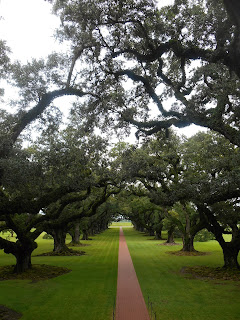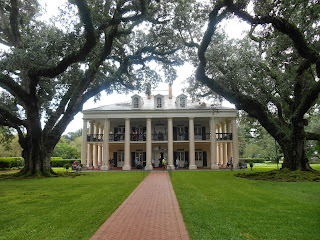Perhaps the most famous plantation in the American Deep South would be Bon Séjour ("good living") plantation. Better known by it's name that riverboat captains dubbed "Oak Alley". The most famous and recognizable feature of the plantation is not the house it self but the 300 year old double row of live oaks about 800 feet (240 meters) long that was planted in the early 18th century, long before the present house was built.
The present mansion was built under the oversight of George Swainy, using mostly enslaved labor, between 1837 and 1839 for Jacques Telesphore Roman and his wife Celina Pilie. Roman's father-in-law, Joseph Pilie, was an architect and probably designed the American styled Greek Revival house. The design is Greek Revival architecture, with some facets of French Creole architecture, which was heavily influenced by Caribbean plantation architecture. The mansion has a square floor plan, organized around a central hall that runs from the front to the rear on both floors. The exterior features a free-standing colonnade of 28 Doric columns on all four sides, a common feature of antebellum mansions of the Mississippi Valley.
At the time Oak Alley was being built, the fortunes of the Roman family had reached their pinnacle. Jacques' brother, Andre was serving his first term as Governor of Louisiana, and his sister Josephine, was married to Francois Gabriel "Valcour" Aime, whose wealth, interest in the sugar industry and opulent life style had won him the title of "Sugar King Of Louisiana". On May 19, 1836, Valcour Aime, sold Jacques Telesphore the plantation riverboat captains later dubbed "Oak Alley".
The house has high ceilings, large windows, a symmetrical facade and interior plan, and a second-floor gallery for viewing the surroundings. The original flooring on the first floor was gray and white marble tile ruined by cows living in the house during the late 19th century (since replaced by hardwood flooring), Also the original spiral staircase was ruined by the cows trying to go up the staircase. The roof was slate, the exterior walls and columns were of stuccoed brick scored and originally painted white to resemble marble.
Bon Séjour was built to be a showplace. Jacques Telesphore Roman younger wife Celina. Was a city girl from New Orleans, she had no interest in plantation life or country living. Although Bon Séjour was a magnificent house, every chance Celina would take the children to the fast paced life of colorful Creole New Orleans in the French Quarter. Sadly Celina and the children were away in New Orleans in 1848 when her husband Jacques Telesphore Roman died, a victim of tuberculosis. Without any experience in business or sugarcane farming, Jacques' wife Celina took over management of the plantation.
Mixing her lack of experience along with her penchant for opulent spending, Celina drove the plantation into near bankruptcy. Jacques' only surviving son, Henri, assumed manhood and responsibility for family affairs in 1859. His valiant efforts to preserve the position and holdings of his family failed against the overwhelming social and political turmoil resulting from the Civil War and Reconstruction, joined the ever-growing tide of once powerful and proud Creoles caught in a downhill slide toward oblivion. Oak Alley, it's land and contents was sold at auction in 1866 to a carpetbagger for $32,800 not making a dent in the debt The Roman family owed.





















































































Thank you so much for this, Andrew. I'd never heard any of the history of this wonderful place. And I didn't know its actual name was Bon Séjour, rather than Oak Alley; I think the former is maybe less descriptive, but much nicer.
ReplyDeleteI'm so fascinated/horrified by the old plantations and their fates - I wrote about a famous lost one in an old blog post of my own: Belle Grove.
http://godsandfoolishgrandeur.blogspot.com/search/label/Belle%20Grove%20Plantation
Love it, actually been up in those trees , climbing, bad boy. Brings back memories. I like.
ReplyDelete